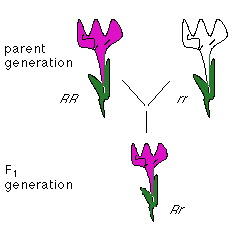Laws of inheritance
- The process of transfer of genetic materials from the parent to their offsprings is where the whole process of heredity is dependent which is known as inheritance.
- This simply means that the passing of genetic information on the same family possesses similar physical or mental characteristics from one generation to another.
- The meaning of inheritance was made clear in a proper way by a scientist named Gregor Johann Mendel who was a Moravian monk around the nineteenth century.
- He formulated his idea of inheritance by performing a simple experiment on a garden pea plant (scientific name – Pisum sativum) that he had planted in his monastery garden.
- Mendel cultivated and tested about 28,000 pea plants in a year between 1856 to 1863 from where he brought on Mendel’s laws of Heredity or Mendelian inheritance which was later published in “Experiments on Plant Hybridization” in 1866.
Why Mendel selected pea plant for his experiment?
Garden pea is an annual plant that can be grown and maintain easily whose life cycle completes within 3 to 4 months. A pea plant is naturally self-pollinating and can also cross-pollinate which makes it easier to study its generation within a short period of time. Because of its clearly distinct and contrasting characters, Mendel selected the pea plant for his experiment.
Mendel experiments
During his experiments, Mendel found that certain unknown factors are involved in the transfer from a parent to offspring. Those unknown factors are now known as genes.
Mendel took a pea plant and listed 7 main contrasting characters:

Two main experiments were conducted by Mendel to determine the laws of inheritance:
- Monohybrid cross experiment
- Dihybrid cross experiment
1. Monohybrid cross experiment
- A monohybrid cross is a cross between two homozygous parents with different single pairs of genetic characters.
- In this experiment, two pea plants, one short and one tall plant were crossed between them where he received a tall pea plant in the first generation offspring which he named F1 progeny.
- Then again he crossed the F1 progeny and received both tall and short pea plants in a 3:1 ratio.
- He even conducted this experiment between other contrasting characters like green peas and yellow peas, round peas and wrinkled peas, purple-flowered peas and white-flowered peas, and many more.
- The results were found to be similar in all the cases from which the law of segregation and the law of dominance were formulated.
- Phenotype is the observable physical appearance of an individual that results from the interaction with genotype.
- The genotype is a set of heritable genes carried by an organism that is transferred from parents to offspring.
- Homozygous is the two copies of the same allele eg. YY, yy and Heterozygous is the different form of a particular gene eg. Yy.
Law of Segregation
- Mendel’s law of segregation states that during meiosis, the two-parent genes separate and get divided into each gametes receiving per alleles.
- The hereditary factor segregates during gamete production so that offspring receives one gene from each parent.
- This is Mendel’s third law of inheritance while the law of independent assortment is the second law and the law of dominance is the first.

Law of dominance:
- Mendel’s law of dominance is the first law which states that in a heterozygote, one allele will dominate the other for the same character rather than contributing to a phenotype.
- The suppressed alleles are called the recessive traits while the determined trait alleles are called dormant traits.
- These two recessive and dormant trait alleles refer to the genotypic interaction of alleles.
- Other researchers have found that the law of dominance does not rely on every time, instead, several different patterns have found to exist.

2. Dihybrid cross experiment
- In a dihybrid cross experiment, two completely different organisms that are heterozygous are identically hybrid for two traits i.e, it carries two different alleles.
- Mendel conducted his experiment on a pea plant that was wrinkled green seed and round yellow seed.
- After crossing these two homozygous and dominant for wrinkled (RR) and green (YY) seeds similarly, homozygous and recessive for the round (rr) and yellow (yy) seeds, he obtained the first generation progeny (F1 progeny) to be a mixed round-yellow heterozygous plant (RrYy).
- The round shape and yellow color were the dominant traits.
- Mendel again self pollinated the F1 generation through which he obtained a 9:3:3:1 ratio with four different traits.
- The 9:3:3:1 ratio describes the nine plants with round yellow seeds, three plants with round green seeds, three plants with wrinkled yellow seeds and one plant with wrinkled green seeds.
- Mendel observed in this experiment that the parental traits sorted independently from one generation to another which was when he formulated his second law of independent assortment.
Law of Independent Assortment:
- Mendel’s law of independent assortment states that a pair of trait separates independently of one another during gamete formation.
- Different traits of individual heredity factors get equal opportunities to occur together.
- The biological selection for one trait does not depend on the selection of any other traits.
- Mendel found support for his law by obtaining a 3:1 ratio result from the monohybrid cross and a 9:3:3:1 ratio result from a dihybrid cross experiment.

References:
- https://byjus.com/biology/mendel-laws-of-inheritance/
- https://courses.lumenlearning.com/boundless-biology/chapter/laws-of-inheritance/
- https://www.khanacademy.org/science/high-school-biology/hs-classical-genetics/hs-introduction-to-heredity/a/hs-introduction-to-heredity-review
- https://www.toppr.com/guides/biology/principles-of-inheritance-and-variations/laws-of-inheritance/
- https://www.glowm.com/section_view/heading/mendelian-inheritance-and-its-exceptions/item/342
- https://www.nature.com/scitable/definition/dihybrid-cross-dihybrid-303/